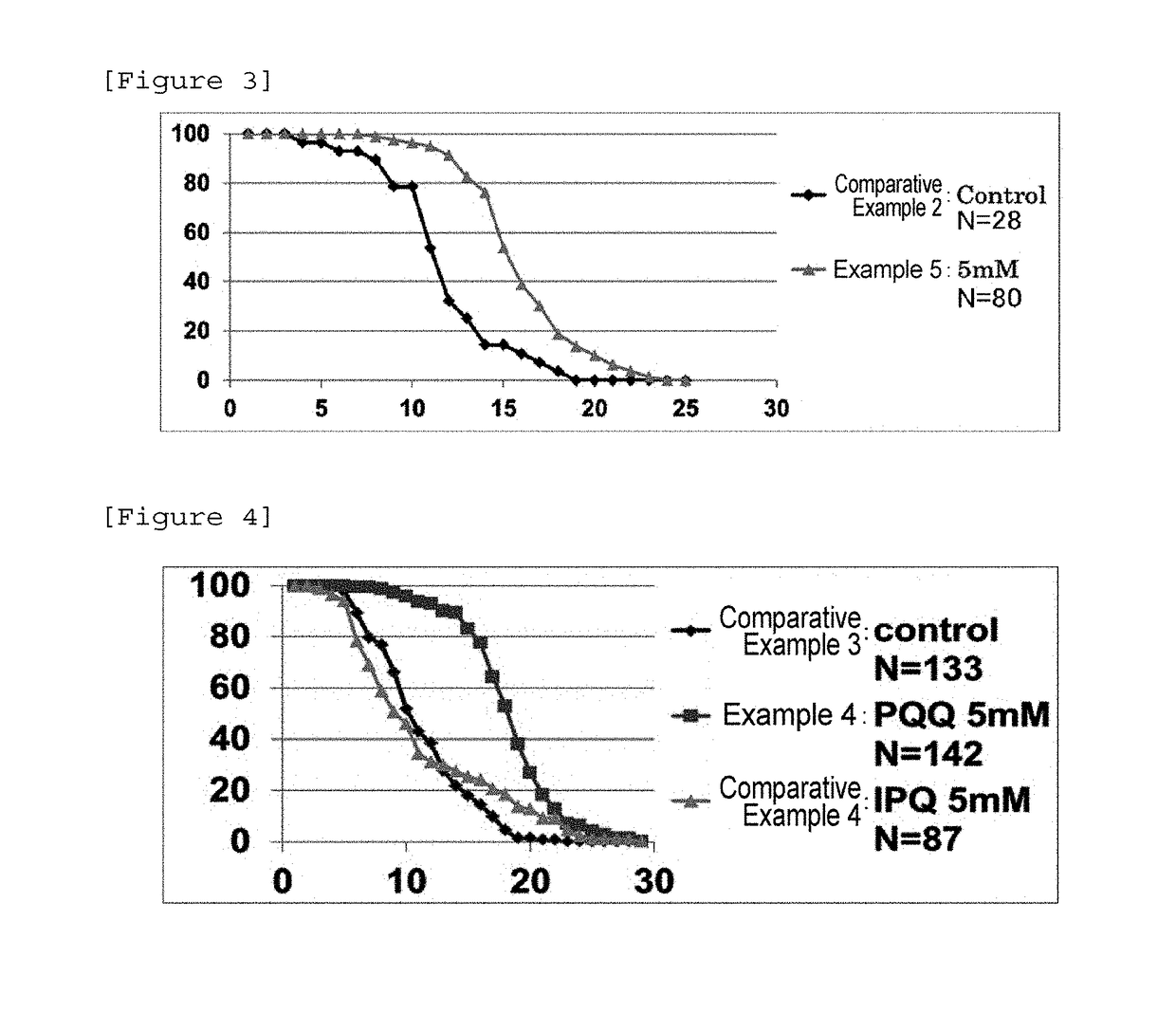Life-extending agent, life extension method using the life-extending agent, novel dual oxidase activator, method for activating dual oxidase, production of life-extending agent, and production of dual oxidase activator
a life-extending agent and life-extending method technology, applied in the direction of antinoxious agents, drug compositions, organic chemistry, etc., can solve the problems of adverse reactions, inability to readily apply, and insufficient safety of gene manipulation
- Summary
- Abstract
- Description
- Claims
- Application Information
AI Technical Summary
Benefits of technology
Problems solved by technology
Method used
Image
Examples
production example 1
line Quinone
[0124]5 g of PQQ disodium salt (BioPQQ manufactured by Mitsubishi Gas Chemical Company, Inc.) and 1 L of water were mixed, and the obtained aqueous solution was warmed to 70° C. This aqueous solution was mixed with a mixed solution containing 50 g of ascorbic acid and 0.2 L of water. The obtained aqueous solution was reacted at 70° C. for 3 days. Then, 10 mL of 2 N hydrochloric acid was added thereto, and the aqueous solution was reacted for 2 hours. Then, the temperature was brought back to room temperature, and the solid deposited in the aqueous solution was filtered and washed with 2 N hydrochloric acid and ethanol. The obtained solid was dried under reduced pressure to obtain 3.6 g of reduced pyrroloquinoline quinone represented by the following general formula (4) as a solid.
production example 2
rroloquinoline Quinone
[0125]11.2 g of PQQ disodium salt (BioPQQ manufactured by Mitsubishi Gas Chemical Company, Inc.) and 1 L of water were mixed, and sodium hydroxide was added thereto to obtain an aqueous solution of pH 9. 200 g of acetone was added to the obtained aqueous solution. As a result, the color of the aqueous solution was changed from red to pale yellow in 20 minutes. The pH of the aqueous solution thus color-changed was adjusted to 2.5 by the addition of hydrochloric acid. The solvent was distilled off from the aqueous solution, and the residue was concentrated until the total weight became 400 g. The yellow solid deposited in the concentrated aqueous solution was dried under reduced pressure to obtain 8.01 g of an acetone adduct of pyrroloquinoline quinone represented by the following general formula (5) as a solid.
production example 3
[0126]100 g of PQQ disodium salt (BioPQQ manufactured by Mitsubishi Gas Chemical Company, Inc.), 200 g of glycine, and 0.5 L of water were mixed to obtain an aqueous solution of pH 4.8. The obtained aqueous solution was stirred for 30 minutes. As a result, bubbles were developed so that the aqueous solution was solidified. The obtained mixture was heated to 70° C. and reacted for 3 days. Then, 1000 g of water containing 10% by mass of NaCl was added to the mixture, and the solid was filtered. The solid thus obtained by filtration was mixed with 120 g of water containing 25% by mass of NaOH and 30 g of water to obtain an aqueous solution of pH 10.8. The obtained aqueous solution was warmed to 70° C. and left overnight. Then, the deposited solid was filtered and washed with 2-propanol and further with 400 mL of ethanol. The obtained solid, 500 mL of water, and 41.5 g of NaOH were mixed to obtain an aqueous solution of pH 10.3. The obtained aqueous solution was left standing overnight ...
PUM
| Property | Measurement | Unit |
|---|---|---|
| Angle | aaaaa | aaaaa |
| Angle | aaaaa | aaaaa |
| Angle | aaaaa | aaaaa |
Abstract
Description
Claims
Application Information
 Login to View More
Login to View More - R&D
- Intellectual Property
- Life Sciences
- Materials
- Tech Scout
- Unparalleled Data Quality
- Higher Quality Content
- 60% Fewer Hallucinations
Browse by: Latest US Patents, China's latest patents, Technical Efficacy Thesaurus, Application Domain, Technology Topic, Popular Technical Reports.
© 2025 PatSnap. All rights reserved.Legal|Privacy policy|Modern Slavery Act Transparency Statement|Sitemap|About US| Contact US: help@patsnap.com



